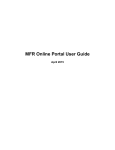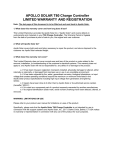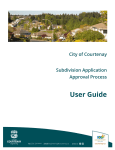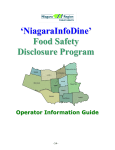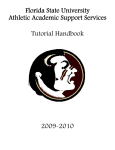Download 130311 ENG Draft Fire Hydrant Operating Instructions
Transcript
District of Squamish 37955 2nd Avenue, PO Box 310 Squamish, BC V8B 0A3 604.815.6868 www.squamish.ca Hydrant Operating Instructions Purpose of Use Purpose of use must be provide by the permit holder and be specific to the intended application. Hydrants are NOT issued for use as potable drinking supply or for filling swimming pools. Backflow Prevention and Hydrant Key The permit holder must: • provide the District with the backflow prevention assembly serial number for the hydrant; • provide the District with a copy of the Backflow Device Test Report (no older than one year) for the backflow device that will be used; • Provide the District with the exact location of the hydrant(s); and • have a hydrant key. Both the key and the backflow prevention assembly can be rented. Fees The fee to use a hydrant is $100.00 per day per hydrant, as outlined in Schedule 6, Fees and Charges Bylaw. Before You Operate A Hydrant Due to the high pressure of hydrants, the potential for a serious accident is very high. Thus, to minimize the requirement for hydrant repairs and the inconvenience to the public, as well as ensure the safety of employees and contractors, these instructions must be followed. Before the hydrant is operated, the following items must be checked: • Inspect all hoses and connections prior to connecting to the hydrant; • Push and pull the hydrant to make sure it is firmly seated in the ground; • Ensure all caps are tightly closed; • Make sure the hydrant is in the “off” position before removing the cap; and • When opening the hydrant with the key, do not stand in front of the caps or the safety valve. CAUTION: Use extreme caution when removing the hydrant caps. The hydrant must be turned off or the hydrant will be under high pressure. Copyright © 2013 District of Squamish | www.squamish.ca | Last Updated: 11 March 2013 Page 1 of 2 How To Operate A Hydrant Follow the steps below to operate a hydrant: 1. Ensure the hydrant is fully closed by turning the large operating nut on the top of the hydrant clockwise. 2. Remove the cap from the 2.5” outlet that you will be using. Do not stand in front of any outlet cap when removing the cap or operating the hydrant. 3. Ensure all other caps are securely closed. 4. A 2.5” control valve must be installed on the open outlet. 5. Fully open the control valve. 6. Open the hydrant slowly (by turning counter-clockwise) to let any air out of the barrel. 7. Close the control valve when water appears. 8. Slowly open the hydrant to the full open position using a hydrant wrench. Do not throttle the hydrant; it must be fully opened to prevent undermining of the hydrant. Do not use a pipe wrench. 9. Open the control valve and let the water run until it is clear. 10. Close the control valve. 11. Install the fill hose on the control valve. 12. Open the control valve to regulate the water flow. 13. When loading is completed, slowly close the control valve. 14. Remove the hose from the control valve. 15. Slowly close the hydrant (turn clockwise). 16. Open the control valve to drain the hydrant. 17. Remove the control valve. 18. Replace the outlet cap after the hydrant has fully drained (approx. 5 to 10 minutes). 19. Do not use excessive torque to close the hydrant. 20. Place the palm of your hand over the outlet; suction will indicate the hydrant is still draining. NOTE: Opening or closing the hydrant too fast may cause a ‘water hammer’ that could cause damage to the infrastructure. Contact Details In case of problems or to report damaged and/or inoperable hydrants, call the District of Squamish Public Works Department at 604.815.6868 (business hours), or after hours on 604.815.4040. Copyright © 2013 District of Squamish | www.squamish.ca | Last Updated: 11 March 2013 Page 2 of 2


